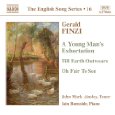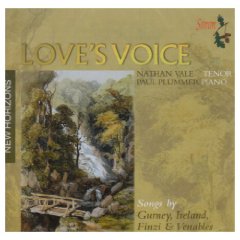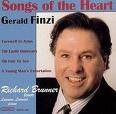Only the wanderer
Poet: Ivor Gurney (1890-1937)
Date of poem: January 1917 (Blevins, 121) - January 18, 1917 (Renas, 226)
Publication date: 1917
Collection: Severn and Somme (1917)
History of Poem: Pamela Blevins writes in her double biography of Marion Scott and Ivor Gurney that the poem was "written in January of 1917 while at Caulaincourt, where in an attempt to find some respite form the vicious cold, Gurney opted to spend the night in a mausoleum of a ruined chateau. He and his fellow soldiers were fully aware that by doing so they risked being blown to bits by German booby traps." (Blevins, 121)
Kim Lawrence Renas writes in his dissertation about Ivor Gurney's songs that the poem was originally entitled simply as: "Song." He goes on to say the collection of poems Severn and Somme, by Gurney was published in 1917 as well. (Renas, 226)
The poem was set to music in March of 1917 by Ivor Gurney. It was published under the title: Severn Meadows in 1928 by Oxford University Press. (Renas, 229)
Poem
| 1 | Only the wanderer | a |
| 2 | Knows England’s graces, | b |
| 3 | Or can anew see clear | c |
| 4 | Familiar faces. | b |
| 5 | And who loves joy as he |
d |
| 6 | That dwells in shadows? | e |
| 7 | Do not forget me quite, | f |
| 8 | O Severn meadows. | e |
Content/Meaning of the Poem: Only someone who has walked about England can appreciate the beauty of the countryside, and can one see more clearly in a new way those "familiar faces" one once knew. And, who wouldn't want to escape from these "shadows" for a moment of joy? Remember me, those of you that live near "Severn meadows."
Speaker: A homesick soldier
Setting: War-torn France during World War I.
Purpose: To lift ones spirits and remind one of how good it was at home.
Idea or theme: Longing for home.
Style: Written in a lyrical style.
Form: Two quatrains with a dimeter rhythm. Gurney uses enjambment on lines: one and two, three and four, and five and six. By using enjambment those coupled lines have a feeling of iambic pentameter.
Synthesis: This poem is not unique in that hundreds of poems and letters are often written by homesick soldiers and yet in its brief eloquent eight lines the visceral images are haunting as only a skilled poet can create. The poem has several layers: in the first stanza one can imagine the places Gurney visited as a boy when he would play and go for long walks in the countryside of England. If we look a little deeper in the first stanza there is an obvious attempt to lift the speakers spirits as he reminds himself of the beauty of his native, England. Peel yet another layer away and we can contemplate Gurney's meaning of "wanderer" does he want us to simply consider a person who enjoys wandering the countryside or could it have a deeper meaning especially considering Gurney's life after the war. For example, he never seemed to find himself even though many considered him to be gifted both as a musician and poet instead he wandered about scraping by with the help of friends until he was hospitalized. The first stanza also reveals regret as well as a message to appreciate life and especially when it is good. The second stanza continues the message to appreciate life's joy but there is also a change in the tone as we picture a soldier cowering in the dark "he that dwells in shadows." On a side note, one can only imagine how a loved one might interpret these lines if they were to receive them in a correspondence. In the last two lines there is desperation in the voice of the speaker as he uses an imperative: "Do not forget." There is no doubt that this poem is a product of war and its awful consequences but there is also a unique perspective of a poet's intellect at work reminiscing about past joys while suffused in the dire nature of battle and its ramifications on the human psyche. This poem is also unique in that it is one of only a few poems that Gurney set to music. (Banfield, 50-1)
✦✼✦✼✦✼✦✼✦✼✦✼✦✼✦✼✦✼✦✼✦✼✦✼✦✼✦✼✦✼✦✼✦✼✦
Musical Analysis
Composition date: 1925 (McVeagh, 35)
Publication date: First published 1965 - © Copyright 1966 by Boosey and Co. Ltd.
Publisher: Boosey & Hawkes - distributed by Hal Leonard Corporation
Tonality: The key signature suggests either A-flat major or F minor but could be better described as modal. There is an occurrence of a dominant to tonic in measure fourteen suggesting A-flat major and also an F minor chord to conclude the song but beyond that the song meanders about never establishing a tonality. Stephen Banfield suggests in his Finzi biography that the song when compared to another of Finzi's "English Hills" that both of them possess a modal influence and are "vague" in their "semi-motivic shapes and gestures." (Banfield, 51) The tonal ambiguity could also be a consequence of Finzi's intentions to make the tonality wander about, thus imitating the title of the song and the opening line, "Only the wanderer."
Transposition: The song is available a minor third lower than the original key. The transposed version may be found in the Medium/Low Voice edition by Boosey & Hawkes entitled: Gerald Finzi Collected Songs 54 Songs Including 8 Cycles or Sets.
Duration: Approximately one minute and fifty-four seconds.
Meter: The song has no meter signature but there are bar lines. The quarter note is indicated in the opening tempo and therefore should be considered the pulse. With this in mind there are eleven measures of 4/4, three measures of 6/4, three measures with 5/4, and three measures of 3/4.
Tempo: Placido is indicated with the quarter note equalling c. 69. The first deviation from the opening tempo is a ritard indicated in measure thirteen in the piano accompaniment. This ritard has the effect of tapering off or fading. The next indication is a tempo in measure fourteen where Finzi suggests A-flat major with a dominant to tonic chord. The return also has the effect of strengthening the resolve of the text, "Don not forget me quite, O Severn meadows."
Form: The form of the song can be best described as through-composed. The unifying elements include a prelude, measures one and two, and postlude, measures eighteen and nineteen, that are practically identical (see examples below).
Prelude in measures 1-2. (Finzi, 74)
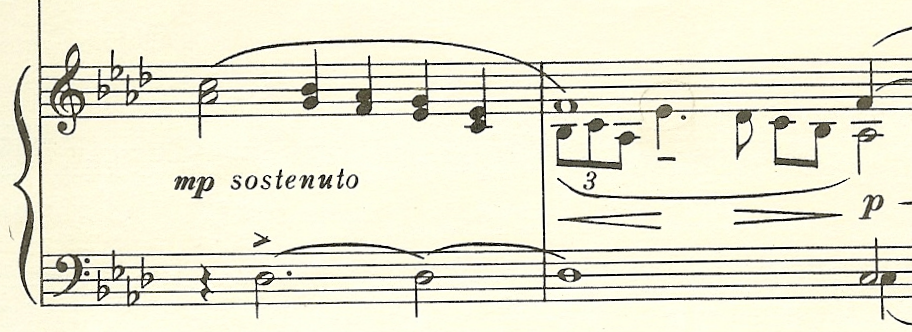
Postlude in measures 18-20. (Finzi, 75)
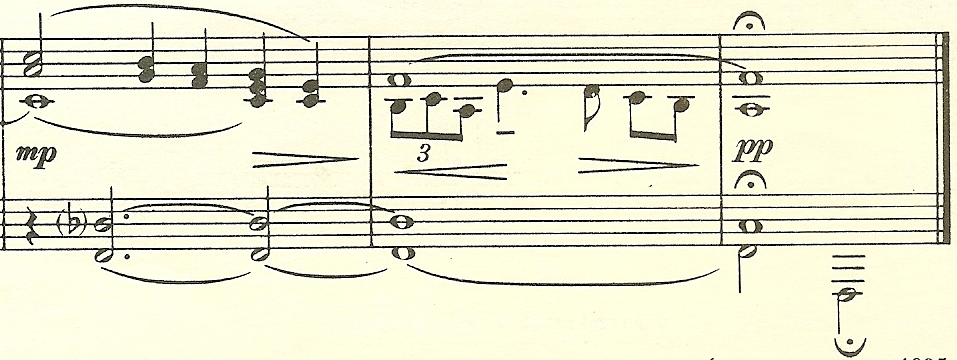
The use of various rhythmic durations tied to triplet figures also have a unifying effect as they occur in both the piano as well as the vocal line (see examples below).
First occurrence of rhythmic motif in the piano accompaniment, measure 2. (Finzi, 74)
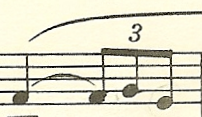
Imitation of rhythmic motif in vocal line, measures 3-4. (Finzi, 74)
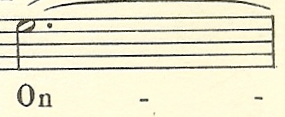
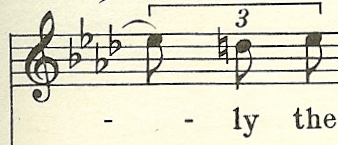
Imitation of rhythmic/melodic motif, measures 3-5. (Finzi, 74)
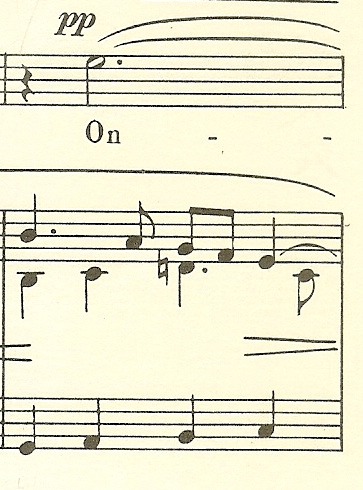
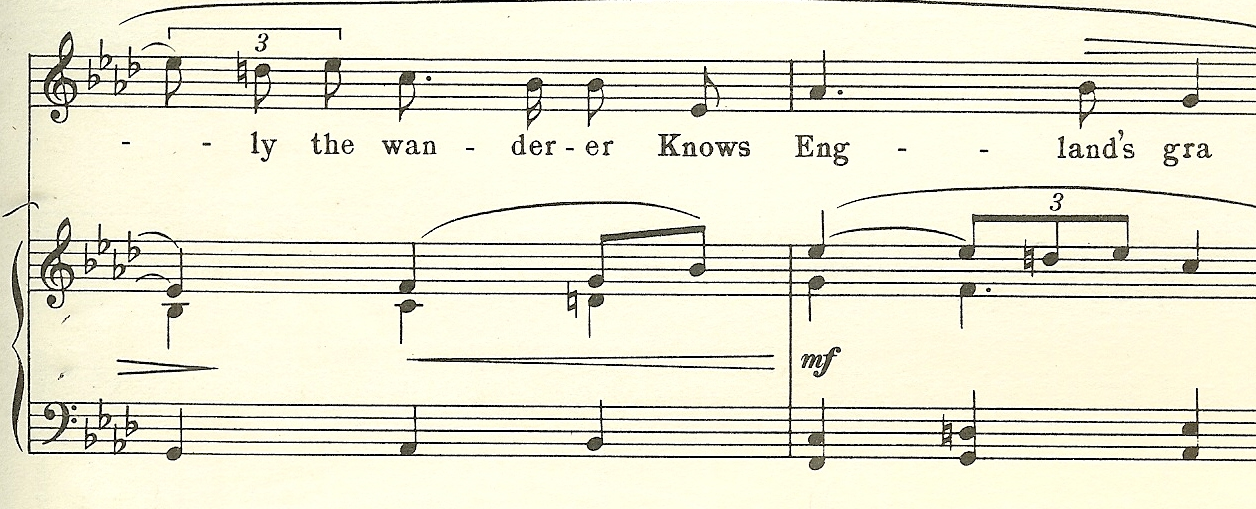
Rhythmic motif imitation in both vocal line and accompaniment, measure 6. (Finzi, 74)
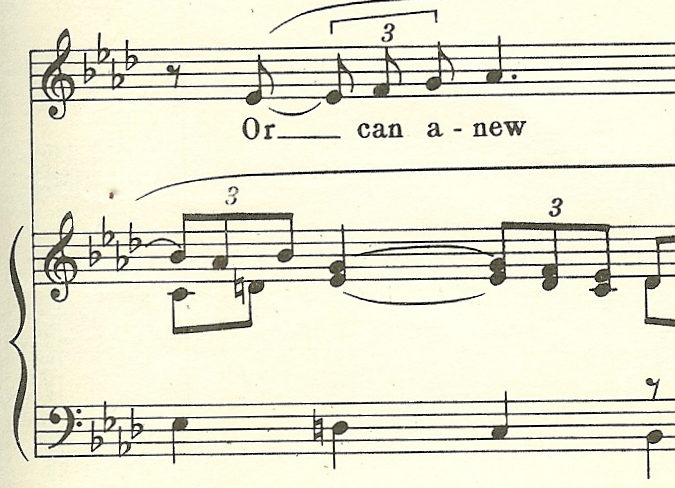
Please note the contrary motion in the melody of the motifs; the vocal line ascends while the accompaniment imitates in a descending manner.
Rhythm: As was mentioned above in the Form category a rhythmic motif involving a triplet figure has a strong unifying effect in the song and as such is the most important rhythmic feature (see examples above).
A rhythmic duration analysis was performed and for the results please refer to: Rhythm Analysis. Information contained within the analysis includes: the number of occurrences a specific rhythmic duration was used; the phrase in which it occurred; the total number of occurrences in the entire song.
Melody: The melodic material is shared between the vocal line and the piano accompaniment. The melodic material found within the rhythmic motifs are the most important melodic features of the song (see examples above in the Form category). The vocal line as well as the accompaniment are written in a typical Finzi style utilizing step-wise motion and small leaps. Larger leaps are used most often to emphasize text or in the case of the piano accompaniment for melodic interest.
An interval analysis was performed for the purpose of discovering the number of occurrences specific intervals were used and also to see the similarities if there were any between stanzas. Only intervals larger than a major second were accounted for in the interval analysis. For a complete description of the results of the interval analysis please see the table at the bottom of the page or click on the link: Interval Analysis. The largest leap within the vocal line is a descending perfect fifth with one occurrence in both stanzas.
Texture: The song has a contrapuntal texture with several occurrences of imitation (see examples above in Form category).
Vocal Range: The vocal range spans the interval of a major ninth. The lowest pitch is the E flat below middle C and the highest pitch is the F above middle C.
Tessitura: The tessitura of the song lies between the E flat below middle C and the E flat above middle C. For a complete pitch count for each stanza please refer to: Pitch Analysis.
Dynamic Range: The piano accompaniment begins at a mezzo-piano dynamic and ends with a final chord at the pianissimo dynamic. The vocal line begins with a pianissimo indicated but this is immediately followed with a crescendo indication. In measure five there is a decrescendo dynamic indicated for the vocal line after which there are no other indications for the voice. The piano accompaniment has at least one dynamic indication in every measure except for measure six. The range is from pianissimo to mezzo-forte.
Accompaniment: The accompaniment is not terribly difficult. The right hand is a little more active than the left with its thirds and triplet figures. Most of the difficulty in the accompaniment will be in realizing the numerous dynamics.
Published comments about the music: Diana McVeagh is a well respected authority on Finzi's music and has made the following comments in her Finzi biography: "There are several undated songs that Finzi may have composed in Gloucestershire; one dated 1925 is of Ivor Gurney's poem that begins 'Only the wanderer'. (Gurney's own setting was published in 1928.) Gurney, from the Somme, looked back longingly to his Severn meadows; Finzi, having decided to leave them, said goodbye in the finest song he had yet written, basing the piano part on the 'cherry-tree' theme of his Severn Rhapsody. Three of the four vocal phrases begin with a sustained note and a tied triplet (x); three contain rising fourths (y), each a third higher than the last; the last bars of the second and fourth phrases 'rhyme' (z), and the opening of the fourth line inverts in retrograde that of the second (w). Such internal reflections give poise to the flowing lyricism (Ex. 2.3). Under the first phrase, the bass rises in warmth; under the last, it sinks in farewell. The song, his only Gurney setting apart from the carol for Ursula Howells, is subtle and touching."
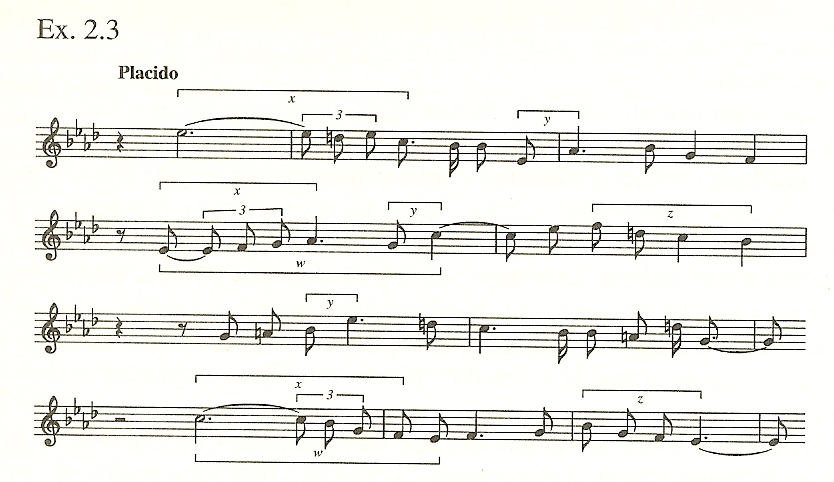 (McVeagh, 35-6)
(McVeagh, 35-6)
Pedagogical Considerations for Voice Students and Instructors: This song is one of the easiest songs in this set and should be accessible to most young tenors. One of the more challenging aspects for younger singers involves the meter as there is no meter signature and to compound matters the piano accompaniment seems to wander or meander. The song is not difficult to count and therefore should not present a problem but if entrances are not clean practice saying the text in rhythm while tapping the quarter-note pulse.
✦✼✦✼✦✼✦✼✦✼✦✼✦✼✦✼✦✼✦✼✦✼✦✼✦✼✦✼✦✼✦✼✦✼✦
| Pitch Analysis | ||||
|---|---|---|---|---|
| pitch | stanza 1 |
stanza 2 |
total | |
highest |
F |
1 |
1 |
|
E |
3 |
1 |
4 |
|
D |
2 |
2 |
4 |
|
middle C |
3 |
2 |
5 |
|
B |
4 |
5 |
9 |
|
A |
2 |
2 |
4 |
|
G |
3 |
5 |
8 |
|
F |
2 |
3 |
5 |
|
lowest |
E flat |
2 |
2 |
4 |
✦✼✦✼✦✼✦✼✦✼✦✼✦✼✦✼✦✼✦✼✦✼✦✼✦✼✦✼✦✼✦✼✦✼✦
Audio Recordings
The English Song Series - 16 |
|
|
|
Love's Voice |
|
|
|
Song Cycles for Tenor & Piano by Gerald Finzi |
|
|
|
Song by Finzi and His Friends |
|
|
|
Oh Fair to See: Songs by English composers |
|
|
|
Songs of the Heart: Song Cycles of Gerald Finzi |
|
|
|

